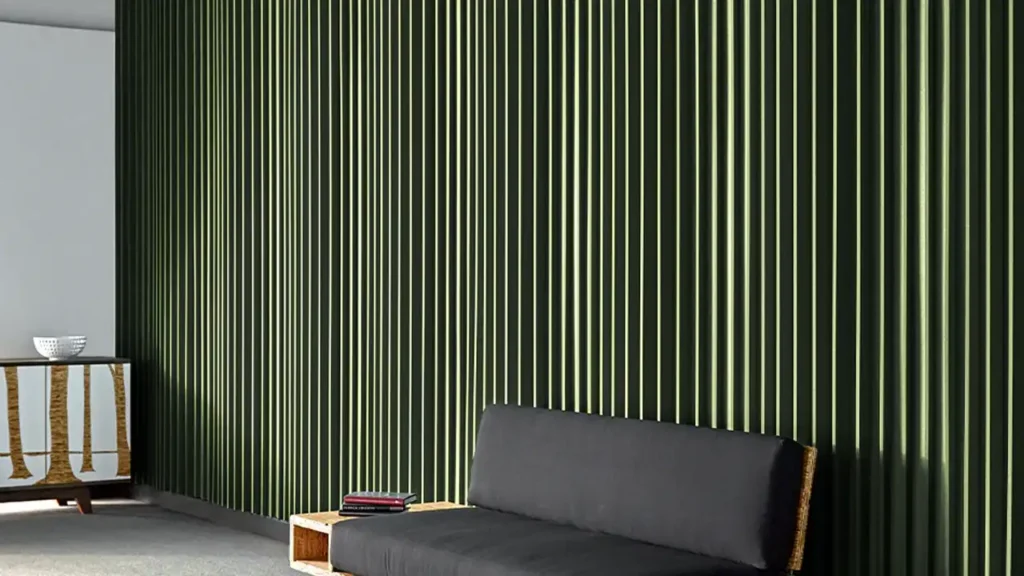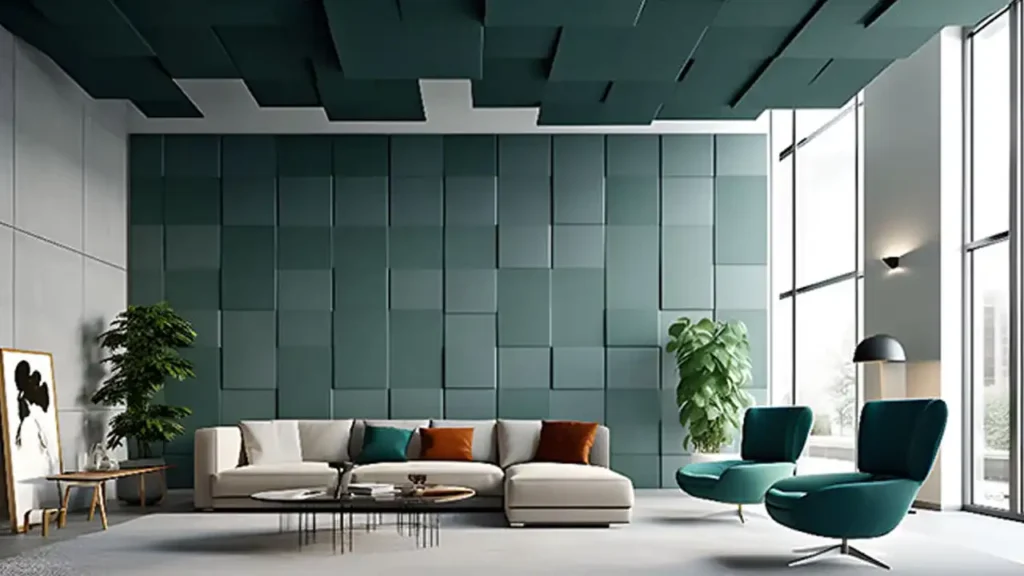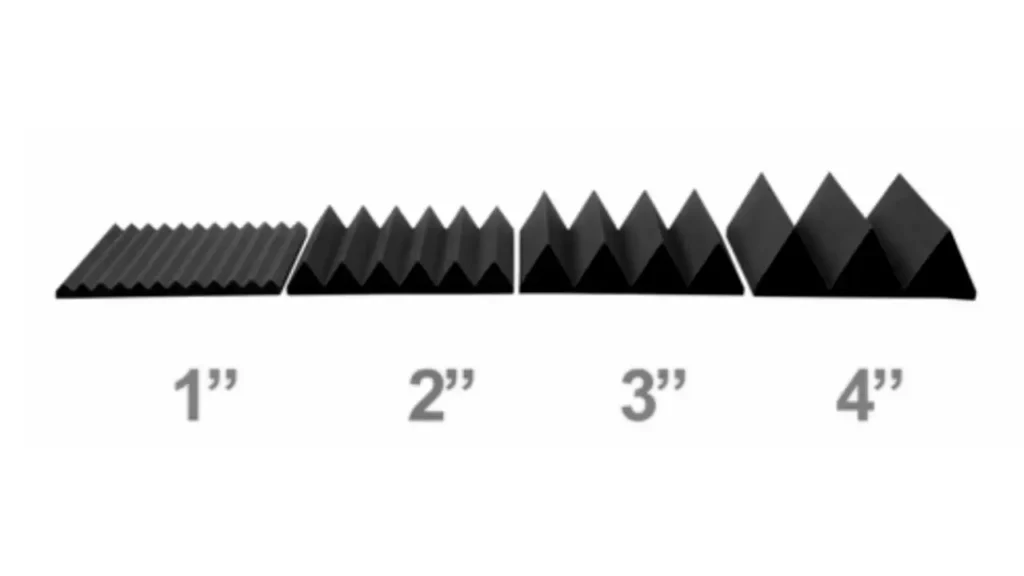Have you ever wondered why your room still echoes despite having acoustic panels installed?
Many people mistakenly believe that acoustic panels alone can completely eliminate noise from their space. While they are effective at reducing sound reflections and improving acoustics, they don’t provide full soundproofing.
In this blog post, we’ll delve into the science behind soundproofing and explore why acoustic panels are just one piece of the puzzle.
We’ll also discuss what it takes to truly soundproof a room and offer practical tips to help you achieve a quieter, more peaceful environment.
Acoustic Treatment vs Soundproofing

Acoustic treatment and soundproofing are often used interchangeably, but they serve very different purposes.
Acoustic Treatment
- Purpose: To improve the sound quality within a space.
- How it works: By absorbing sound waves and reducing echoes, acoustic treatment enhances clarity, reduces reverberation, and creates a more balanced listening experience.
- Common applications: Music studios, home theaters, and concert halls.
- Examples of materials: Acoustic panels, bass traps, diffusers.
Soundproofing
- Purpose: To block sound from entering or leaving a space.
- How it works: By creating a barrier between the space and its surroundings, soundproofing reduces noise transmission.
- Common applications: Bedrooms, offices, and industrial facilities.
- Examples of materials: Mass-loaded vinyl, insulation, sealed doors and windows.
In essence, acoustic treatment focuses on the internal sound quality of a space, while soundproofing focuses on the external noise control.
Want to learn more about the specific differences and how to achieve both in your room? Let me know and I can provide more detailed information and recommendations.
The Purpose of Acoustic Panels

Acoustic panels are primarily designed to improve the sound quality within a space. They achieve this by:
1. Absorbing Sound Waves:
- Reducing Reverberation: By absorbing sound waves, acoustic panels help to reduce echoes, which can be distracting and impair sound clarity.
- Improving Sound Definition: This reduction in reverberation allows individual sounds to be heard more distinctly, enhancing the listening experience.
2. Controlling Sound Reflections:
- Preventing Standing Waves: Standing waves occur when sound waves bounce back and forth between parallel surfaces, creating areas of high and low sound pressure. Acoustic panels can help to diffuse these waves, preventing them from forming.
- Balancing Sound Distribution: This diffusion helps to ensure that sound is evenly distributed throughout the room, reducing “hot spots” where sound is excessively loud.
3. Enhancing Acoustic Treatment:
- Complementary to Other Measures: Acoustic panels often work in conjunction with other acoustic treatments, such as bass traps and diffusers, to create a more balanced and controlled acoustic environment.
Acoustic panels play a crucial role in optimizing the sound quality of a space by managing sound reflections, reducing reverberation, and improving overall sound clarity.
Problems with Low-Quality Acoustic Panels

1. Ineffective Sound Absorption
- Incorrect NRC Ratings: Some manufacturers may exaggerate the noise reduction coefficient (NRC) of their panels, leading to disappointment when they fail to perform as expected.
- Limited Frequency Range: Low-quality panels might only be effective at absorbing certain frequencies, leaving other noise sources unaddressed.
2. Durability Concerns
- Material Degradation: Inferior materials can become brittle, sag, or discolor over time, reducing their effectiveness and appearance.
- Poor Construction: Loosely packed materials or inadequate bonding can lead to panels that fall apart or become damaged during installation or use.
3. Health Hazards
- Off-Gassing: Some low-quality panels may emit harmful chemicals into the air, causing headaches, respiratory issues, or other health problems.
- Mold and Mildew Growth: If panels are not properly treated or installed, they can become breeding grounds for mold and mildew, which can also pose health risks.
4. Unsightly Appearance
- Cheap Materials: Low-quality panels may use materials that are visually unappealing or difficult to integrate into existing decor.
- Poor Finish: A rough or uneven finish can detract from the overall aesthetic of a room.
5. Installation Challenges
- Lack of Mounting Hardware: Some panels may not come with the necessary hardware or instructions for easy installation.
- Difficulty Cutting: Low-quality panels may be difficult to cut to size, leading to a messy installation process and potential damage.
6. Limited Warranty or Support
- Short Warranty Periods: Limited warranties may leave you vulnerable to repair or replacement costs if the panels fail prematurely.
- Lack of Customer Service: Poor customer service can make it difficult to resolve issues or obtain replacement parts.
By understanding these potential problems, you can make more informed decisions when purchasing acoustic panels and ensure that you invest in a product that will provide long-lasting benefits and value.
Why Your Acoustic Panels Don’t Soundproof Your Room

While acoustic panels can significantly improve the sound quality within a room, they are not typically designed to completely block sound from entering or leaving. This is because they primarily focus on absorbing sound energy rather than blocking sound transmission.
Here’s a breakdown of why acoustic panels may not provide full soundproofing:
- Nature of Sound: Sound travels in waves, and blocking it requires creating a barrier that is dense and heavy enough to reflect or absorb the sound energy completely. Acoustic panels, while effective at absorbing sound within a space, are often not dense enough to effectively block sound transmission.
- Airborne vs. Structure-borne Sound: There are two main types of sound transmission: airborne and structure-borne. Acoustic panels are primarily designed to address airborne sound, which travels through the air. However, they are less effective at blocking structure-borne sound, which travels through the walls, floors, and ceilings.
- Air Gaps and Openings: Even if you have properly installed acoustic panels, any gaps or openings in your walls, doors, or windows can allow sound to leak through, reducing the effectiveness of the soundproofing.
- Complexity of Soundproofing: Achieving true soundproofing often requires a multi-layered approach that involves a combination of materials and techniques, such as:
- Airtight seals: Sealing all gaps and openings in walls, doors, and windows with weatherstripping, caulking, and door sweeps.
- Mass-loaded barriers: Adding dense materials like mass-loaded vinyl or soundproofing panels to walls, floors, and ceilings to block sound transmission.
- Resilient channels: Using resilient channels to decouple walls and ceilings from the building’s structure, reducing the transmission of vibrations.
- Damping materials: Adding damping materials like soundproofing foam or fiberglass to absorb sound energy within the structure.
In short, while acoustic panels can significantly improve the sound quality within a room, they are not a one-size-fits-all solution for soundproofing. To achieve true soundproofing, you may need to consider a combination of different materials and techniques.
Here are some additional tips to enhance soundproofing:
- Seal all gaps and openings: This includes doors, windows, electrical outlets, and light fixtures.
- Add weatherstripping to doors and windows: This helps to create a tighter seal and reduce air leakage.
- Install door sweeps: Door sweeps can help to block sound from underneath doors.
- Use caulk and sealant to fill any gaps in walls and ceilings.
- Consider using soundproofing curtains or blinds: These can help to reduce noise transmission from outside windows.
- Upgrade to a solid core door: Solid core doors are denser and heavier than hollow core doors, which can help to block sound better.
- Install resilient channels: Resilient channels can help to decouple walls and ceilings from the building’s structure, reducing the transmission of vibrations.
- Add insulation to walls and ceilings: Insulation can help to absorb sound energy and reduce noise transmission.
Remember, soundproofing is a complex process that requires a multi-faceted approach. It’s important to consider all of your options and choose the right materials and techniques for your specific needs.
How to Choose Good Acoustic Panels
Choosing good acoustic panels involves several key considerations:
- Noise Reduction Coefficient (NRC): The NRC rating measures a panel’s ability to absorb sound at different frequencies. Higher NRC ratings indicate better sound absorption. For general applications, an NRC rating of 0.5 or higher is often considered good.
- Frequency Range: Different panels absorb sound at different frequencies. Consider the specific frequencies you want to reduce (e.g., low frequencies for bass, mid-frequencies for vocals, high frequencies for treble) and choose panels that address those ranges effectively.
- Thickness and Density: Thicker and denser panels generally offer better sound absorption, especially for low frequencies. However, thicker panels can be bulkier and more expensive.
- Material: Acoustic panels can be made from various materials, including fiberglass, rockwool, polyester, and wood. Each material has its own strengths and weaknesses in terms of sound absorption, durability, and aesthetics.
- Size and Shape: The size and shape of the panels will affect their coverage and performance. Larger panels can cover more surface area and provide better overall absorption. However, smaller panels may be more suitable for specific applications or for creating a visually appealing design.
- Installation: Consider how the panels will be installed. Some panels can be easily hung on walls using adhesive strips or brackets, while others may require more complex installation methods.
- Aesthetic: Choose panels that complement the design and decor of your space. Consider factors such as color, texture, and shape.
- Budget: Acoustic panels can vary in price depending on their size, material, and quality. Determine your budget and choose panels that fit within your financial constraints.
- Professional Consultation: If you have complex acoustic needs or are unsure which panels are best for your space, it’s recommended to consult with an acoustic professional. They can assess your room’s acoustics and recommend the right products and installation methods.
Here are some additional tips for choosing good acoustic panels:
- Consider the size and shape of your room: Larger rooms may require more panels than smaller rooms.
- Pay attention to the placement of the panels: Placing panels strategically can help to maximize their effectiveness.
- Use a combination of different panels: Combining panels with different NRC ratings and shapes can help to address a wider range of frequencies.
- Consider the aesthetics of the panels: Choose panels that complement the design of your space.
- Factor in the cost of installation: Professional installation can add to the overall cost of the project.
- Read reviews and testimonials: Before making a purchase, read reviews and testimonials from other customers to get an idea of the quality and performance of the panels.
By following these tips, you can choose the right acoustic panels for your needs and create a more comfortable and acoustically pleasing environment.
Do Thicker Acoustic Panels Offer Better Soundproofing?

Yes, thicker acoustic panels generally offer better soundproofing.
Thicker panels have more mass, which helps to absorb and reflect sound waves more effectively. This is particularly true for low-frequency sounds, which can penetrate thinner materials more easily.
However, it’s important to note that the thickness of the panels is not the only factor to consider. Other factors such as the material used, density, and installation method also play a role in soundproofing effectiveness.
In general, thicker acoustic panels can be a valuable tool for improving soundproofing in a room, but they may not be sufficient on their own. For optimal results, it’s often necessary to combine thicker panels with other soundproofing measures, such as mass-loaded barriers, resilient channels, and airtight seals.
What are the main benefits of acoustic panels in a room?
Acoustic panels offer several key benefits in a room, including:
Improved sound quality: By reducing echoes and reverberation, acoustic panels enhance sound clarity and definition, making it easier to hear and understand conversations and music.
Reduced noise levels: Acoustic panels can help to absorb unwanted noise, such as traffic noise or sounds from neighboring rooms, creating a quieter and more peaceful environment.
Enhanced privacy: By reducing noise transmission, acoustic panels can help to improve privacy in spaces where confidential conversations take place.
Improved acoustics for music and audio: Acoustic panels can create a more balanced and controlled acoustic environment, which is ideal for music studios, home theaters, and other spaces where sound quality is important.
Enhanced comfort and productivity: A quieter and more acoustically pleasing environment can contribute to increased comfort, reduced stress, and improved productivity.
Why can’t acoustic panels stop noise from outside?
While acoustic panels are effective at improving the sound quality within a room, they are not designed to completely block noise from outside. Here’s why:
Airborne vs. Structure-borne Sound: Acoustic panels are primarily designed to address airborne sound, which travels through the air. However, many external noises, such as traffic noise or sounds from construction sites, are transmitted through the building’s structure (structure-borne sound). Acoustic panels are less effective at blocking structure-borne sound.
Air Gaps and Openings: Even if you have properly installed acoustic panels, any gaps or openings in your walls, doors, or windows can allow outside noise to enter.
Frequency Range: Acoustic panels are often designed to absorb a specific range of frequencies. Some external noises may be outside of this range, making it difficult for the panels to block them effectively.
Sound Intensity: If the external noise is very loud or intense, it may be difficult for acoustic panels to completely block it, even with proper installation.
To effectively block external noise, you may need to combine acoustic panels with other soundproofing measures, such as:
Mass-loaded barriers: These are dense materials that can help to block sound transmission.
Resilient channels: These can help to decouple walls and ceilings from the building’s structure, reducing the transmission of vibrations.
Airtight seals: Sealing all gaps and openings in your walls, doors, and windows can help to prevent noise from entering.
By combining these measures, you can significantly reduce external noise and create a quieter, more peaceful environment.
Can I use both soundproofing methods and acoustic panels in one room?
Yes, you can absolutely use both soundproofing methods and acoustic panels in the same room. In fact, combining these approaches can often provide the most effective results for noise control.
Here’s a breakdown of how they work together:
Soundproofing: This involves blocking sound from entering or leaving a space. It typically involves techniques like adding mass-loaded barriers, resilient channels, and sealing gaps and openings.
Acoustic Panels: These are designed to absorb sound within a space, reducing echoes and improving sound quality.
By using both methods, you can:
Block external noise: Soundproofing methods can help to prevent outside noise from entering the room.
Improve internal acoustics: Acoustic panels can enhance the sound quality within the room, making it more pleasant and comfortable.
Reduce noise transmission: By reducing both external noise and internal reverberation, you can significantly reduce noise transmission overall.
Here are some examples of how you can combine soundproofing and acoustic panels:
Add mass-loaded barriers to your walls and ceilings, then install acoustic panels to absorb any remaining sound within the room.
Seal all gaps and openings in your walls and doors, then use acoustic panels to reduce echoes and improve sound quality.
Install resilient channels to decouple your walls and ceilings from the building’s structure, then add acoustic panels to absorb sound within the room.
By carefully considering your specific needs and combining soundproofing and acoustic panels, you can create a space that is both quiet and acoustically pleasing.
Are all acoustic panels made of the same material?
No, acoustic panels are not all made of the same material. There are several different materials commonly used for acoustic panels, each with its own unique properties and benefits.
Here are some of the most popular materials used for acoustic panels:
Fiberglass: This is one of the most common materials used for acoustic panels. Fiberglass panels are lightweight, durable, and have good sound absorption properties.
Rockwool: Rockwool is a mineral wool made from volcanic rock. It is fireproof, moisture resistant, and has excellent sound absorption properties.
Polyester: Polyester panels are lightweight, durable, and have good sound absorption properties. They are also available in a wide range of colors and textures.
Wood: Wood panels can be used for acoustic purposes, but they are typically used in combination with other materials to improve their sound absorption properties. Wood panels can add a natural and aesthetic element to a room.
Foam: Foam panels are lightweight and have good sound absorption properties. They are often used in home studios and recording rooms.
The best material for your acoustic panels will depend on your specific needs and budget. Consider factors such as the sound frequencies you want to absorb, the desired thickness and density, and the overall aesthetic of your room.
What’s the difference between decoupling and damping in soundproofing?
Decoupling and damping are two important techniques used in soundproofing, but they serve different purposes.
Decoupling involves separating a component from its surroundings to reduce the transmission of vibrations. This is often achieved by using resilient channels or isolation mounts. For example, decoupling a wall from the building’s structure can help to prevent vibrations from traveling through the walls and causing noise.
Damping involves absorbing sound energy and reducing vibrations. This is typically achieved by using materials that are dense, heavy, and have high internal damping properties. Examples of damping materials include mass-loaded vinyl, lead sheets, and constrained layer damping materials.
Decoupling focuses on preventing the transmission of vibrations, while damping focuses on absorbing sound energy.
To achieve effective soundproofing, it is often necessary to combine decoupling and damping techniques. For example, you could decouple a wall from the building’s structure using resilient channels and then add a layer of damping material to the wall to absorb any remaining vibrations.
Conclusion
While acoustic panels offer a significant improvement in sound quality, they are not a one-stop solution for soundproofing. To effectively block noise from entering or leaving a space, you may need to combine acoustic panels with other soundproofing measures, such as mass-loaded barriers, resilient channels, and airtight seals.
By understanding the limitations of acoustic panels and implementing a comprehensive soundproofing strategy, you can create a quieter and more peaceful environment.
Ready to take the next step in improving your space’s acoustics?
Explore our wide selection of high-quality acoustic panels at wholesale prices. Our experts can also provide personalized guidance to help you achieve your desired soundproofing goals.
